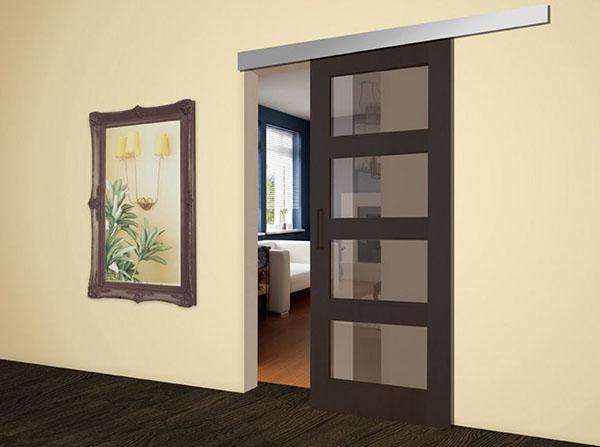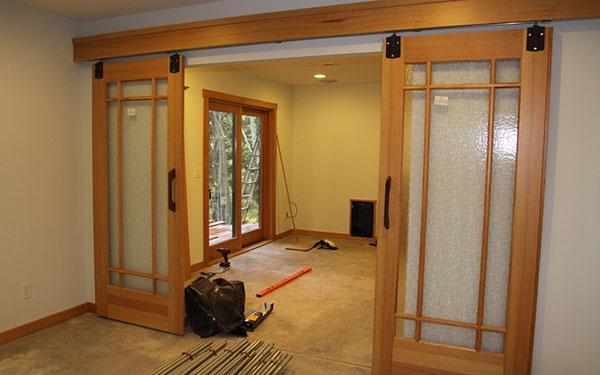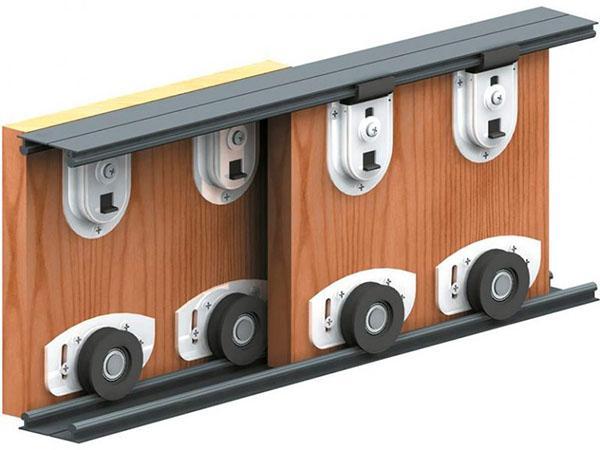Sliding interior doors: installation features and scope
 Sliding interior doors, which have many models and can be used in any premises, have become quite popular in the interior of apartments. With their help, living rooms are divided into several zones and improve the design of an apartment or house. Sliding doors are especially popular in small apartments, combining limited space (see. DIY installation of interior doors).
Sliding interior doors, which have many models and can be used in any premises, have become quite popular in the interior of apartments. With their help, living rooms are divided into several zones and improve the design of an apartment or house. Sliding doors are especially popular in small apartments, combining limited space (see. DIY installation of interior doors).
Sliding interior doors: installation methods

- manufacturing method;
- the material used;
- decorative coating.
By manufacture, panel and panel products are distinguished. They are performed in a blank form and with glazing. The material for production is solid wood, fibreboard and chipboard, MDF boards. Veneer imitating natural wood of different species, lamination and melamine surface are used as decoration.
A sliding door is, first of all, a product that combines wood, metal and glass elements with high-quality fittings and functional mechanisms.
Installation methods
Installation of sliding interior doors is done in two main ways:
- using two guides;

- using one guide.

In the first case, the doors move along rails that are installed on the floor and ceiling. The second option involves the installation of one rail above the doorway.
A cheaper and more affordable option is to install sliding doors along two tracks.
Sliding interior doors move with rollers that move along guides. It is especially important to maintain the horizontal surface of the floor and the beam on the ceiling, where the upper guide is installed. Otherwise, the door on rollers will move spontaneously. In some cases, metal clamps are used, but they can ruin the overall appearance of the product.
The use of the second installation option - along two guides, has a more aesthetic appearance. There is no plank obstacle on the floor. When the doors are rolled back, the spaces of adjacent rooms smoothly connect to each other.
The canvas itself is moved by the movement of rollers that move along a guide mounted on the ceiling. The number of rollers depends on the type of door leaf.
There are also more innovative sliding door systems. These include the cassette installation method. In this case, the door leaf is hidden in a niche. It is not difficult to install sliding doors with your own hands using a cassette system, although this option is considered the most expensive.
The design of interior sliding doors provides that the movement system is completely built into the wall. It is necessary to equip a niche with a built-in metal frame. For this purpose, a section of the existing wall is destroyed and a plasterboard box is made.
The work can be complicated if the wall into which the box with the cassette unit is mounted is load-bearing. Before making a sliding door with your own hands, you must obtain permission for such repair work.
Installing doors in this way allows you to conveniently place furniture or household appliances and does not reduce the area of the room.
Types of sliding doors and their scope
 One of the most popular models is the sliding compartment door system. This is the safest option for families with small children. They open without undue effort.
One of the most popular models is the sliding compartment door system. This is the safest option for families with small children. They open without undue effort.
 Sliding door has a silent sliding system that does not create extraneous sounds when moving the canvas. The design has sound insulating properties. It is attached to the ceiling and walls using special cassettes. They are quite expensive, so a false wall system for sliding doors is more popular.
Sliding door has a silent sliding system that does not create extraneous sounds when moving the canvas. The design has sound insulating properties. It is attached to the ceiling and walls using special cassettes. They are quite expensive, so a false wall system for sliding doors is more popular.
When using this mechanism, the door is placed along the wall and moves with guides installed on the floor and on the ceiling.
 The door leaf is made of aluminum profile and glass composite. The second option is more unique. Fiberglass composite is a transparent material made of fiberglass and is particularly durable. It does not rot and is not afraid of the influence of chemical solutions used to clean the surface.
The door leaf is made of aluminum profile and glass composite. The second option is more unique. Fiberglass composite is a transparent material made of fiberglass and is particularly durable. It does not rot and is not afraid of the influence of chemical solutions used to clean the surface.
Often veneered sliding doors are used in the interior of the house. They are made from aluminum profiles. In appearance, the doors resemble a natural wood product, but much cheaper.
It is considered a budget option to install an accordion sliding door in the house. In the recent past, they were made from cheap plastic and were installed instead of doors in closets and other utility rooms.
Modern accordion doors are made of metal, glass and wood. They are successfully used in the design of modern apartments. With the help of such sliding doors, the space of one-room small apartments is zoned.
When sliding doors are installed
 Sometimes, in order to decorate the interior of the house, the use of sliding interior doors is required. This applies to such cases:
Sometimes, in order to decorate the interior of the house, the use of sliding interior doors is required. This applies to such cases:
- The need to close a large opening. It happens that a standard double-leaf door cannot cope with this task, and besides, it takes up a lot of space.
- With a catastrophic lack of space in the apartment. This confirms the main advantage of sliding doors - freeing up space. The design of some rooms does not provide for traditional swing doors at all.
- Zoning of premises. Sliding doors are especially useful when combining living room and kitchen. When dining with guests, the effect of being in a large spacious kitchen is created. Sliding doors can also be used to combine a corridor and a dressing room.
- Room space correction. With the help of sliding doors, you can adjust the door and window openings of the loggia. If installed in the form of an arch, the opening becomes wider and higher, which improves the overall design of an apartment or house. The space of the room is also adjusted in height by mounting the upper guide in the ceiling niche.
- In the presence of dimensional furniture in the house. The interior sliding door allows you to arrange furniture close to the doorway.
A sliding interior door is also used when replacing an interior partition. The latter is limited in the choice of appearance and material from which it is made. Then, as a sliding door can complement any interior.
Sliding door designs
 Each type of sliding door design solves separate functional tasks in arranging the space of a house or apartment. Depending on the tasks, such options for their design are distinguished:
Each type of sliding door design solves separate functional tasks in arranging the space of a house or apartment. Depending on the tasks, such options for their design are distinguished:
- Parallel sliding. The door leaf moves along the upper guide along the wall. It also has another name - barn doors.

- Cascading. Existing canvases (two, three or more) move apart to the sides, hiding one after the other, in the form of a "stack".

- Harmonic.The canvas not only shifts to the side, but also folds.

- Sliding door. The door leaf, made of any material, moves along two guides - above and below.

- Cassette. The sliding door structure is hidden in a niche made inside the wall.

Do-it-yourself installation of sliding interior doors, the video is posted below, in addition to the advantages, it also has some disadvantages.
The roller mechanisms generate noise when opening. Such a door is almost impossible to move silently. This is especially inconvenient in the morning. During long-term operation, the sounds when opening are only amplified.
Over time, components wear out - rollers and carriages. They need to be changed more frequently than, for example, hinges and locks for swing doors.
Installation of sliding interior doors, taking into account the cost of installation, the cost of components and the canvas itself, will cost more than standard doors. Sliding doors have less sound and heat insulation, since there is a gap between the leaf and the wall, which cannot be removed.
Which doors to give preference to - swing or sliding depends on the individual preferences of the homeowner. However, a sliding interior door solves the issue of saving free space in small rooms.